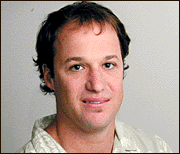

![]()
The why of tech


![]()
The why of tech
There's a few words in our language whose meaning are so closely related, they are often incorrectly used. Accurate and precise have got to be at the top of that list. Any time you hear anyone say, "Precisely!" in agreement to something that was said, chances are high they are using it incorrectly. Digital offers enough
precision for anyoneI wear a bunch of different hats: sometimes editor, sometimes technology journalist, sometimes computer consultant, so it was the first of these jobs that discovered this common misuse, but the third that figured out these two words are the key to making digital work.
It's important to realize both words can only be used as modifiers of information. Flowers, for example, cannot be accurate or precise. Only devices that give information can, such as blueprints and watches.
A precise watch is one that allows to you determine not only hours, minutes and seconds, but also fractions of seconds. Stopwatches are precise watches. They allow one to measure hundredths of a second. The more detailed information a device can give, the more precise it is. But just because a watch is precise does not mean it is accurate. If a stopwatch reports three seconds as being 2.997 seconds, it is not accurate. Because it showed thousandths of a second and it was off by three thousandths, it is a watch that cannot be trusted.
Conversely, the less precise something is (i.e., the less detailed information something gives) the higher the chance of it being accurate. Watches that only have an hour hand can be as much as 59 minutes off while still being accurate. Perhaps you've worked with people who use this strategy. The point is, in the analog world if you want accurate and precise it's going to cost you HUGE bucks.
The magic of digital is it seemingly breaks these rules by using the same technique as the child's game, 20 Questions.
First, by using a binary code, the digital system breaks all data into a minimum of precision -- specifically, a zero or one (or yes and no, in the case of the game) -- that ensures the most accuracy. Next, just like the child's game, it allows multiple pieces of data to be strung together to create precision. In the game, you ask 20 questions which provide enough detail to answer virtually any question.
With digital, 20 binary pieces strung together gives over a million options (2 to the 20th power) -- more than enough precision for virtually any task.
Steve Jefferson is a Honolulu-based freelance writer
and section editor for InfoWorld. He can be
reached at: stevej@lava.net